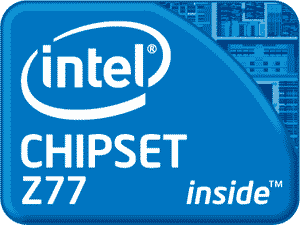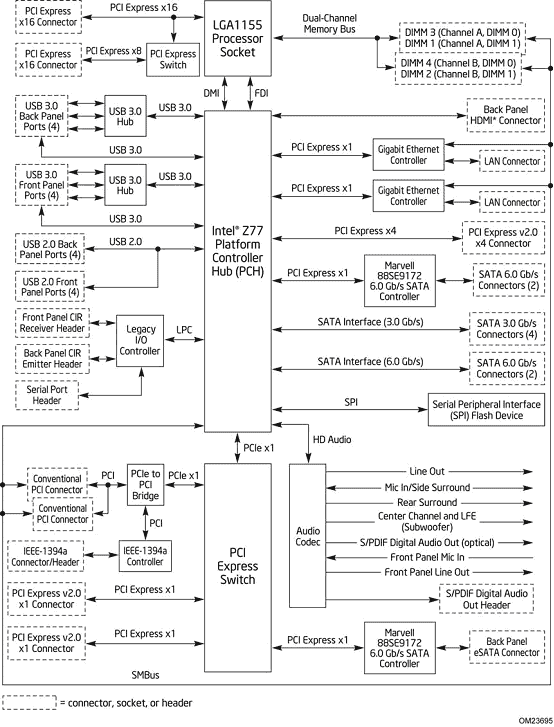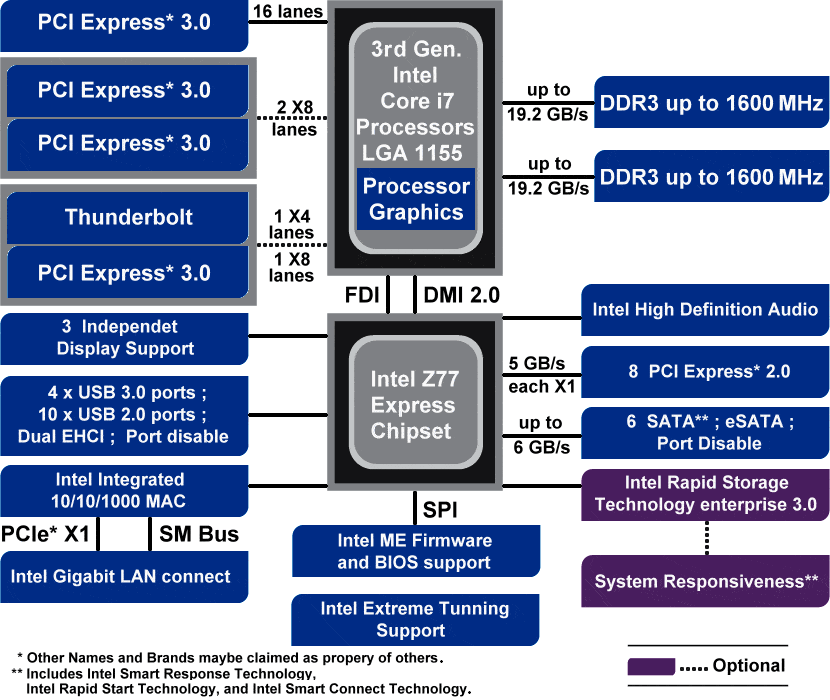amazon Chipset Z77 reviews
Z77 chipset
The diagram above shows the design of the Intel DZ77GA-70K motherboard. According to the Z77 chipset can manage two SATA 3 ports, four USB 3.0 ports and eight PCI Express 2.0 lanes. RAM still only works in Dual Channel. It does not look much different than the Z68.
Out of the margin a bit. All new Ivy Bridge chipset motherboards including the H77, Z75 and Z77 all support iGPU playback (if the CPU is available). And Intel’s iGPU HD 4000 promises to be more powerful than the HD 3000 on Sandy Bridge.
PCI Express 3.0: double bandwidth 2.0
The next generation chipset and CPU still have only 16 lanes of PCI Express for VGA, but 3.0 interface for twice the bandwidth of 2.0. This provides the ability to add multiple graphics cards better without worrying of congestion. With 16 lane we can have the following scenarios: x16 single card bandwidth, x8 / x8 dual card and x8 / x4 / x4 three card. With twice the bandwidth, x4 PCI Express 3.0 is equivalent to x8 PCI Express 2.0 – just enough for high-end VGAs running SLI or CrossFire. Of course, it is a necessary and sufficient condition to own a Z77 motherboard, Ivy Bridge processor and PCI Express 3.0 graphics card.
In the near future, it is possible that 32-lane PCI Express 3.0 motherboards will be available for more advanced users. This is done with the support of the PCIe 3.0 PLX PXE chip, and most likely this chip is only available on high-end motherboards. The personal writer claims that 16 lane 3.0 is sufficient for most users.
USB 3.0 interface: no transfer chips needed
On the H61, H67, P67 and Z68 motherboards, the USB 3.0 port has been around for a long time, but through a third-party transfer chip. The Z77 chipset is capable of self-managing four USB 3.0 ports, usually two ports. In the back panel I / O and two ports on the main to connect to the front of the case (depending on the manufacturer, depending on the product). There are opinions that the 3.0 port speed of the Z77 chipset manages a bit faster than port 3.0 through the transfer chip.
It’s not yet clear whether you need to use this USB 3.0 interface, but with the temptation to cram everything that’s possible from today’s motherboard manufacturers, at least this will reduce the cost. Transfer chip.
RAM speed: faster and faster
If you use both the Z77 and the Ivy Bridge, you can reach 2800MHz – a big jump over Sandy Bridge’s 2133 MHz. This is due to the splitter and the OC bclk and Ivy Bridge capabilities. To be honest, few RAM kits can run at this level.
That is the case in the mid-range and high-end products, while in the lower plate, Z77 and Ivy Bridge also support the level of RAM up to 1600 MHz (compared with 1333 MHz on H61 today). This is really good news because we all know how Intel’s platform makes good use of RAM.
Support to export 3 monitors
Users can export up to 3 monitors without using a discrete graphics card, provided that the motherboard has 3 or more output ports (some only 2). Multi-monitor solution provides a very good working and entertainment environment, compared to a monitor.
Electric used
Although not officially launched but based on written information, Ivy Bridge top-end processors have a power consumption (TDP) of only 77W. This is the magic of the 22nm process, but with that, Ivy’s performance is unlikely to improve much compared to Sandy. A lot of people will be disappointed with this and ask the question: why Intel does not keep TDP to improve performance?
No one can answer this question except Intel, but looking in the other direction, TDP reduction means the number of power phases on the motherboard can be reduced! Without taking into account the price, it’s likely that the Ivy Bridge platform will have better p / p than Sandy Bridge.
Backend support Sandy Bridge
If H61, H67, P67 and Z68 motherboards can support Ivy Bridge CPUs via BIOS update, H77, Z75 and Z77 will also support Sandy Bridge. This could lead to a question: “I do not need PCI Express 3.0, nor do I need USB 3.0, so should I choose Z77 or Z68?” This may be an overwhelming question if the Z77 motherboards are not more expensive than the Z68 (comparing the same segment) or the Z77 for better performance than the Z68. But what about in the opposite case? In this article I will answer the second issue of the problem, while the first one must wait for the Z77 to fully launch new conclusions.
New technology: Rapid Start & Smart Control
Before talking about Rapid Start, I would like to reiterate a little about the three sleep modes of Windows: Sleep, Hibernate and Hybrid Sleep. These two modes are very user-friendly because the on / off time is much faster than shut down, and all content that is active when shut down remains the same when you turn it on.
– Sleep: All data on the computer will be transferred to RAM. When a user returns to work, any unfinished content such as an application, the open file will be “popped” out almost immediately. In this mode the system does not turn off completely, still consumes electricity because the RAM will lose data when the power is off. Of course, if you lose power when you are sleeping, all your work will be lost.
– Hibernate: Instead of saving content to RAM, Hibernate mode uses the hard drive. In this mode, the system shuts down completely, does not consume much power but starts up much slower than sleep due to loading from the hard drive.
Hybride Sleep: This is a combination of both modes. When used in this mode, work status is saved to both hard drive and RAM (of course, it still consumes power). If there is no power failure, when the system will load the system will load from RAM, and if the power will load from the hard drive.
As such, we can see that the three modes are limited: fast startup, running still slow startup. Rapid Start is simply an improvement over this, with the “small” requirement of supporting an SSD! Accordingly, Intel takes advantage of SSD’s ultra-fast, loading the work state into it instead of the HDD, so the system shuts down completely but starts up fast. In other words, Rapid Start is actually a Hibernate that uses SSDs with a slight difference: Hibernate saves work on the operating system partition, and Rapid Start can be saved to any SSD in the system.
If you just think about it, many people think Rapid Start is not like a trivia game, but do not hurry like that! Remember, Intel still has SSD technology caching! This technology uses a small SSD to cache the operating system’s HDD, speed up the system a lot – extremely useful if you can not afford to buy a large enough SSD to install. Thus, Rapid Start does not have the application of stand alone, but it is very beneficial if combined with SSD caching.
Another new technology is less application-oriented than Smart Connect: social networking updates, mail, cloud services … even when the machine is sleeping. The principle is simple: after a certain period the system … automatically start, update and then sleep. The biggest problem of Smart Connect is the support service. So far, only Sobees and Seesmic Desktop have provided interactivity to a number of social networks, Microsoft Outlook, and Windows Live Mail.
Virtu MVP (HyperFormance & Virtual Vsync): Ground for the iGPU
Contrary to our initial misunderstandings and expectations, HyperFormance does not improve game performance. The real meaning of this feature is reduced mouse / key feedback time, which results in more accurate processing. Virtu MVP’s license is built into the motherboard, not retail and hard to crack. The only way to own a Virtu is to buy a motherboard that is equipped with software, not just a 30-day trial. Currently Virtu MVP is still in the development phase, supporting few games and encountered many bugs.
AsRock Z77 Fatal1ty Professional
The motherboard we use is the AsRock Z77 Fatal1ty Professional – currently the most advanced motherboard of the AsRock Z77. I will just give you a quick glimpse of this motherboard as it is not the main character today.
Looking at the motherboard, the most noticeable spot is the immediate three PCI Express slots for the graphics card (in red). However, the third slot runs only with 2.0 x4 bandwidth, the other two are PCI Express 3.0, running in x16 (single VGA) or x8 / x8 (2 VGA) or x8 / x8 (x VGA) or x8 / x8 (x VGA). I think if all three slots are 3.0 standard, the x8 / x4 / x4 distribution to run 3 VGAs will be more reasonable.
The Z77 Fatal1ty Professional uses a 16 + 8: 16 power source design for the CPU and 8 power sources for the iGPU, supporting OC maximum. I do not understand how the company made 8 phases for iGPU to do, just 4 is enough. The number of source phases for RAM is up to 4, perhaps to serve OC up to 2800 MHz
There are six SATA 3 ports on the motherboard, but only two are managed by the Z77 chipset, while the other four through the AsMedia transfer chip, so the speed is lower.
On the motherboard integrates both reset buttons, power and a 2-digit LED for bug reports. Before booting up to the hard drive, the 2 reset buttons and the light emitting lights show up on the Fatal1ty logo.
The number of I / O ports is huge, satisfying the needs of the connection. There is a Clear Cmos button to reset the BIOS in case OC fails again.
where can you get a Chipset Z77 online
Biostar Intel LGA1155 Z77 Chipset ATX 2600MHz DDR3 Memory Motherboard (TZ77XE3): Buy it now
Intel DZ77SL-50K LGA 1155 Desktop Board, ATX Form Factor, Z77 Express Chipset 1600MHz Motherboard with I/O Plate: Buy it now
– 1 x PS / 2 Keyboard / Mouse Port
– 1 x HDMI Port
– 1 x DisplayPort
– 1 x Optical SPDIF Out Port
– 5 x Ready-To-Use USB 2.0 Ports
– 1 x Fatal1ty Mouse Port (USB 2.0)
– 1 x eSATA3 Connector
– 6 x Ready-to-Use USB 3.0 Ports
– 2 x RJ-45 LAN Ports with LED (ACT / LINK LED and SPEED LED)
– 1 x IEEE 1394 Port
– 1 x Clear CMOS Switch with LED
– HD Audio Jack: Rear Speaker / Central / Bass / Line in / Front Speaker / Microphone
Of the six USB 3.0 ports on the back I / O, only two are managed by the Z77 chipset, and the other four are managed by the Etron EJ188H chip. We may find it unreasonable here: By stuffing too many USB and eSATA ports plus adding a Clear Cmos button to the I / O panel, AsRock is forced to cut its output port, leaving only two small HDMI ports And Display Port. Not all screens are equipped with these two ports, and Z77 Fatal1ty Professional users certainly can not use iGPU to output three monitors. Should set the clear Cmos button in the same group reset button, power is more reasonable.
On the Z77 Fatal1ty Professional, AsRock decided to keep the “old” connection ports such as IDE, Floppy Disk, COM … Many people think that this is unnecessary waste, probably the price of the motherboard may be cheaper a little without them.
BIOS UEFI
Z77 Fatal1ty Professional’s BIOS UEFI is no different than its predecessor Z68. This interface is very nice and friendly, can use both the mouse and keyboard to control.
The custom parameters are identical to the Z68 Fatal1ty Professional. Notably, the bclk allows pulling up to 150. The upcoming Ivy Bridge processors have the ability to pull bclk – one more point than Sandy Bridge. There are also five OC options available for inexperienced users, including 4.0 GHz; 4.2 GHz; 4.4 GHz; 4.6 GHz and 4.8 GHz.
Users can save OC settings to 3 profiles to call out when needed. This is a very useful feature for users, appearing on every segment of AsRock products.
Section OC RAM. Regrettably, the RAM is only raised to 2133 MHz (not unlike the Z68). Maybe Ivy Bridge chip can pull higher.
AsRock’s BIOS has a slightly annoying feature where the offensive Enhanced Halt State (C1E) technology is not in the same place as other CPU tweaks.
Overclocking on Z77
First of all, Sandy Bridge processor overclocking on the Z77 is no different than the Z68 or P67.
As soon as I started, I tried boosting bclk to 108. As a result, I could not boot into main, clear the BIOS. So we are still forced to increase multiplier to overclock, bclk only increase very limited. According to the information available to date, Ivy Bridge will allow overclocking bclk – a good news for the OCer.
Switch to RAM overclocking, although the Z77 Fatal1ty Professional supports up to 2800 MHz of RAM. But in the bios, the divider only allows up to 2133. So 2133 is the limit of the Sandy Bridge, albeit increased to 2200 if used. Asus motherboard.
After a few operations, the highest pulse I achieved was 5.1 GHz with a voltage of 1.50V. This level touches the threshold of heat dissipation I use should not be pressed higher. The highest clock that can boot into Windows is 5.5 GHz with a voltage of 1.60V. Well, I suppose the overclocker’s ability to do this is due to the good quality of components, the high number of phases of the Z77 Fatal1ty Professional and not the Z77 chipset. Many other high-end Z68 motherboards can also achieve this level.
Conclude
Honestly, there are very few reasons to upgrade to the Z77 if you are using the Z68 motherboard, as few people can take advantage of their improvements. The points here are:
– USB 3.0 support, no transfer chip needed: although there is news that the speed of USB 3.0 port managed by the Z77 chipset is a bit faster, but I do not think users can recognize this ” Or your USB flash drive is fast enough to block the bandwidth of the chip.
– PCI Express 3.0: Except for the case of running three graphics cards with x8 / x4 / x4 bandwidth or running two dual-core cards (equivalent to Quad SLI or Quad CrossFire), I do not think there will be bandwidth bottlenecks on PCI Express. 2.0. Further to take advantage of this, must meet all three conditions: motherboard slot 3.0, Ivy Bridge CPU, graphics card 3.0 – the new machine
– High RAM: This is a great value for the Z77, especially when Ivy Bridge allows bclk overclocking. But you have to own a very high RAM can reach this level.
– Export 3 screens: this feature is also very noticeable. Using multiple monitors can track jobs, switching back and forth very easily. With the power of integrated graphics, you probably can not play games with multiple monitors.
– Rapid Start & Smart Connect: In these two technologies, Rapid Start is more application-oriented. Maybe in the near future I will be doing a detailed review on it.
Lack of appeal in the field of upgrades, but if you are a new buyer, there is no reason not to opt for the new Intel chipset platform because of their price, or more just a little bit. Not only that, the chipset itself can handle more, plus the Ivy Bridge’s low power consumption will result in savings in components such as switching chips and power phases. We can fully expect the market to regulate and new products have better p / p present.


